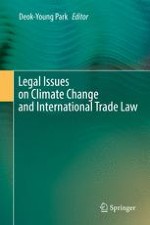2016 | OriginalPaper | Chapter
Compatibility of Eco-Labeling Scheme with WTO and Its Potentially Conflicting Impacts
Author : Soyoung Lee
Published in: Legal Issues on Climate Change and International Trade Law
Publisher: Springer International Publishing
Activate our intelligent search to find suitable subject content or patents.
Select sections of text to find matching patents with Artificial Intelligence. powered by
Select sections of text to find additional relevant content using AI-assisted search. powered by
